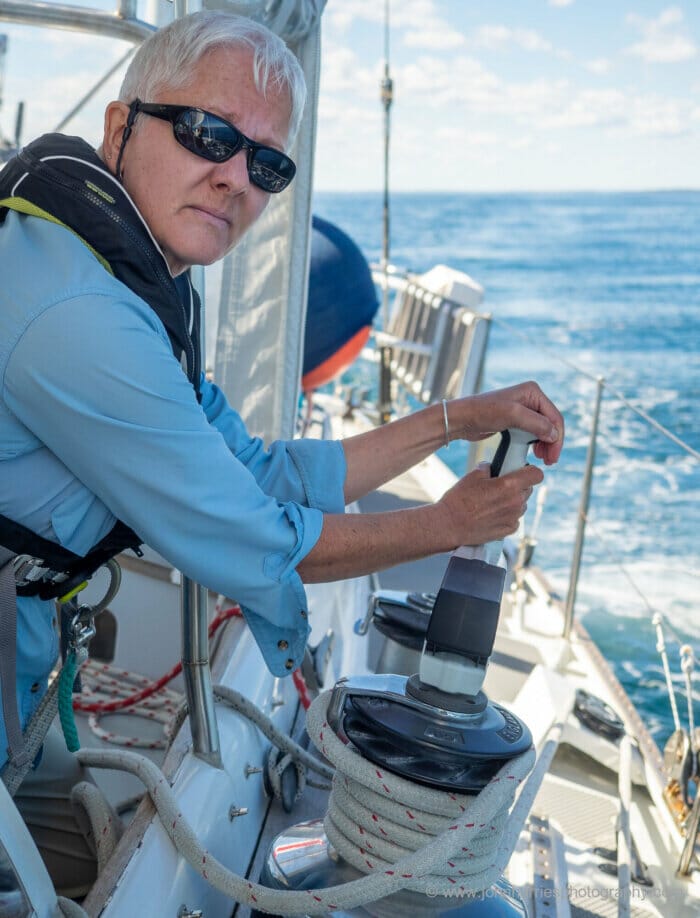© Attainable Adventure Cruising Ltd and the authors, all rights are reserved.
Nothing on this website or in direct communications received from us, or in our articles in the media, should be construed to mean or imply that offshore voyaging is anything other than potentially hazardous. Dangers such as, but not limited to, extreme weather, cold, ice, lack of help or assistance, gear failure, grounding, and falling overboard could injure or kill you and wreck your boat. Decisions such as, but not limited to, heading offshore, where you go, and how you equip your boat, are yours and yours alone. The information on this web site is based on what has worked for the authors in the past, but that does not mean it will work for you, or that it is the best, or even a good way for you to do things.


This is a great line. Good job on the word smithing. 🙂
“…would result in having your hand extruded through the clutch.”
Very vivid.
Later,
Dan
Hi Dan,
Thanks for the kind words.
Hi John, just wondering . . . how many winch handles go overboard during the lifetime of the average enthusiastic cruising sailor? In other words, what is the risk of one’s e-wincher going the same way? And can this be insured against?!!
Hi Peter,
Good question. Believe it or not, I have never lost one, or even seen someone else do so. I think the key is to have a rule that the handle is either locked into the winch (automatic) or in its pocket. And given that the eWincher automatically locks in, I think it would be hard to lose one.
As to insurance, I guess it would depend on your policy and particularly the deductible. Most policies I have seen cover gear, so I don’t see why eWincher would be an exception. That said, a claim for one would probably result in the loss of any no claim discount and/or might result in a premium increase the next year, so probably not worth it in most cases.
Seldèns E40i electric winch should also be taken into consideration in this discussion.
https://www.seldenmast.com/products/winches/
I don’t have any experience with it, and the price is unknown, but it for sure looks promising.
This is what Seldèn tels in their advertise:
“The E40i winch is built up around an electric motor which is totally integrated in the drum. Only three thin cables are protruding to lead through the coach roof or the deck, no large cutouts and no external motor or gearbox. This makes for uncompromised headroom down below which is normally not the case with electric winches.
The three speed operation provides a high speed gear, a moderate gear and a low speed gear for fine tuning. It is a two finger operation to start the winch and to swich gear, so a single-handed sailor can helm while adjusting the trim”.
Hi Henrik,
That is indeed interesting, and the price is right too: https://www.defender.com/product.jsp?id=6795561
The catch appears to be that it won’t run directly off a 12 V or 24 V DC supply, but requires a dedicated 42 V DC bus supplied by a Seldén DC-DC converter, plus a dedicated CAN bus for control, and a Seldén motor controller for each winch.
To be fair, that’s probably the right call, from an engineering standpoint. It means that your long twisty runs are made with 8 or 10 AWG cable instead of 2 or 4 AWG, and the higher voltage is necessary to fit the motor inside the drum like that, which you just wouldn’t be able to do at a lower voltage. Separating the MCU from the motor is, again, a good modern practice; it gives you more choices for mounting things in tight spaces, and means that five or ten years from now, you only have to replace what actually broke.
It’d be easy to integrate on a new build, rather more difficult as a refit, and I’d be inclined to apply the usual AAC caution to new and not-thoroughly-proven systems, at least until more evidence is available. Notably, I don’t see a handle socket for manual override in the event of a power failure.
Hi Matt,
Thanks for taking a dive into that! Looks to me like a fairly good option for a single fairly low load function like a main halyard lead aft, but not really an option for primaries, except maybe on very small boats.
Hi Matt,
Looking at the x-ray images on their site, it can be confirmed that they have no manual operation option. Since the motor is inside the drum, there’s no space for the gears needed for manual winching. The winches are probably very reliable, but long distance cruisers need a backup plan for all essential functions. That could in this case be snatch blocks in the right places to use other available winches when needed. Probably good enough?
Great series. Question: do you think the ewincher would serve the same Jordan drogue retrieval purpose as your drill adaptation? I am still set up to use a nipper line to the bow and back to the cockpit primaries. Works, but time-consuming.
Hi Terence,
Yes I do, although you might have to stop and let it cool down a little more often than with the Milwaukee since the voltage is lower.
It looks like Power Arm is now called Power Wincher with new URL: https://www.powerwincher.com.au/
Thanks for the in depth review. We’ve been using our Milwaukee drill motor for a couple of years now and, while useful, are thinking of upgrading to a more purpose-built device.
Hi Brian,
Thanks for the heads up on the change. Looks like they have certainly improved the product, but even so the bulk and lack of waterproof rating would still push me toward the eWincher, which has also been improved since our review.